|
Title: | British Railways First Generation DMUs |
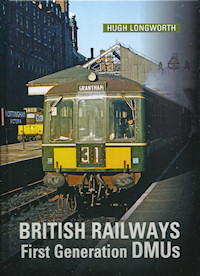
|
| Author: | Hugh Longworth |
| Publisher: | Crecy Publishing Ltd (as OPC) |
| Format: | Book |
| Subject: | Multiple Units |
| Category: | Detail |
| Spec: | A4 hardback, 304 pages, 142 B&W photos, 48 colour photos. ISBN: 978-1-80035-253-7 |
| Publication date: | 2022 |
| Summary: | Another epic from Hugh Longworth, this is a revised version of the original 2011 publication, and it will tell you everything you ever wanted to know about BR DMUs (but were afraid to ask) |
| Review: | This title was originally published in 2011 but I somehow missed it at the time, which was a shame as it soon became very hard to find second-hand except at crazy prices. Fortunately, it was updated and revised in late-2022. The GBP35 price tag may seem high, but this is a thick, high-quality book, packed with information. Books detailing particular types of trains often seem to focus either on data or on photos, but Hugh has managed quite a nice combination of the two. The masses of information make this an excellent reference work for the subject, while the photos mean it can also be dipped into more casually.
The format will be familiar to anyone who has Hugh's other books. Every number is listed and its history shown. Dates for introduction, refurbishment, withdrawal, scrapping, renumbering and regional re-allocation are all provided, and there are plan and side views (taken from BR's own diagrams) for each type. The information is shown (of necessity) using various symbols and codes and these do take a little getting used to.
The changeable attributes of allocations and formations (and set numbering) are not really compatible with the format of the main section of this book, hence they have been covered in a separate section. This uses snap-shots at particular dates, with allocations for example shown at 10-yearly intervals. Formations considered to be 'stable' are listed by depot and set number. An adequate compromise, and I don't think I could have come up with a better solution. If you like DMUs (and/or railway 'data'), buy this book. |
| Reviewed: | 07/03/2023 by Thomas Young (Comments made by others can appear in the notes section towards the bottom of this page) |
| Sample pages: | (Click on any image to view full-sized in a new window)

With printed hard-back covers, this book has a quality (and heavy) feel to it.
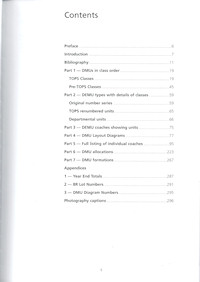
The contents page shows the way the subject has been broken down into fairly logical sections.
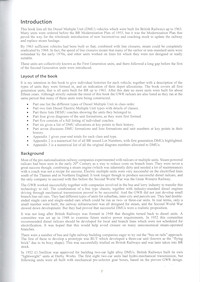
The 5 page introduction gives an overview of BR's DMUs and outlines how the detailed information in the following sections has been presented.

Part 1 gives a history of each class, then lists the initial set formations and first allocations. Each class is headed with a colour photo. The organisation by TOPS class numbers (introduced in the 1970s) is slightly anachronistic but probably the most logical way.
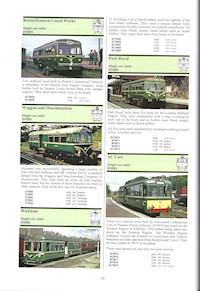
Colour photos have been found for almost every type, including the 4-wheel railbuses. I don't think I've ever seen the Bristol/ECW versions in colour before.
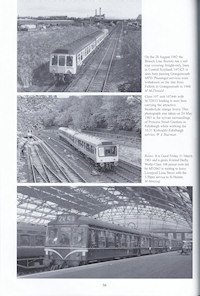
Photographic interludes are scattered throughout the book, with large, well-reproduced monochrome images from most stages of the subject's lives.

The Southern Region DEMUS are also covered (as are the Blue Pullmans), although they are treated slightly differently due to having fixed set numbers.
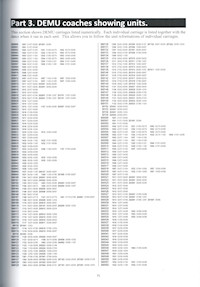
What could have been an appendix appears after the DEMU classes, and shows all the coaches in numerical order with details of all the sets they were formed into (with dates).
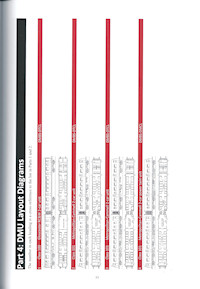
The 18 pages of part 4 show (diagrammatically) the various formations of DMU and DEMU. Printed in landscape orientation, I am not sure of the value of this section, given that larger diagrams of each coach type appear later.
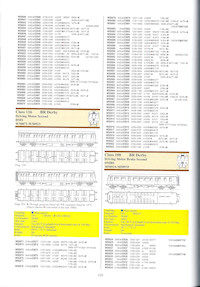
Part 5 is the 'meat' of this book, and has its own 3-page introduction. It then lists every coach number, with dates of operation, renumberings, regional allocations etc. Each batch is headed with a diagram and lot/design details, all printed in colour.

The GWR railcars are also included, but not the various prototype DMUs/railcars used by other companies. The author explains that the GWR units were included because they remained in operation at the time BR's own DMUs were introduced.
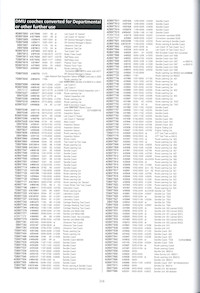
Another page that could have been an appendix, this one lists all DMU coaches that were converted for departmental use (including internal users and private-owners).

Hugh's coach and EMU books did not cover allocations, but this one does. A 44-page section shows allocations at 10 yearly intervals (from 1960 to 2000). Allocations are shown printed in the appropriate regional colour (eg orange for North Eastern), though some are hard to distinguish.
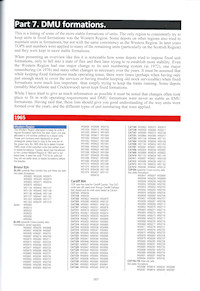
Tackling the variable formations of DMUs is tricky. The approach here is to show selected formations at selected dates from 1965 to 2010. Formations are shown per depot, with set numbers where appropriate. Only 'stable' formations are included, in particular those on the Scottish and Western regions. |
| Notes: |
No notes have been left yet. ?There may be some notes posted but which have not yet been approved.
|
| Edits: | This item has not been edited.
|

 Register
Register